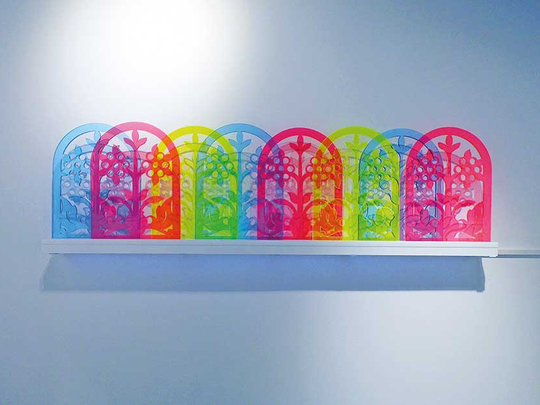
UAE-based Japanese-American artist Colleen Quigley’s latest exhibition in Dubai, The Remarkable Resilience of Symbols, explores the flow and transformation of elements of material culture. The artist has used patterns, decorative symbols and signs found in the urban landscape of Dubai to highlight the migration of such elements and the changes they undergo across time and space.
Quigley studied art in the US and Japan and has been teaching art at a university in the UAE for the past 14 years. She works with various materials and media including sculpture, installation, encaustic, ceramic and glass. Her versatility is reflected in the variety of artworks in the show.
“The idea for this body of work was triggered when I was invited last year by Sikka Art Fair to create a piece relating to the community that developed in the historic Al Fahidi area. I began looking at the traditional ornamental designs in the architecture of the area, which are based on gypsum screens used in turn of the century Persian architecture, called Khodamuni architecture after the Khaleeji term for expatriate Persian communities. I chose to focus on the many ‘flower in a vase’ patterns that are found in the old wind-tower houses here. My research indicated that these motifs are ancient and appear in Indian design, but also have roots in classical Mediterranean design. They also appear in design template books published in the UK and floating around the British empire during the late 19th and early 20th centuries. This shows that such symbols do not have a fixed identity. They stay with us but are continuously reimagined, transformed and recontextualised, often in surprising ways. I decided to continue the tradition of appropriation and adaptation of the designs by taking one simple ‘flower in a vase’ pattern out of its context as an architectural element in a window and replicating it as a sculpture but with a few alterations and with new materials and techniques to give it a contemporary look,” Quigley says.
The result is a work titled Electric Khodamuni, where the artist has laser cut her version of the motif on transparent acrylic panels in various fluorescent colours. The panels have been arranged in layers such that the pattern is replicated but also new patterns and colours are generated at the points where the panels or their shadows overlap.
“This work refers to the transcultural migration of patterns and design symbols by highlighting how patterns are adapted and retranslated across time and space, reminding us that culture is fluid and not fixed,” Quigley says.
The idea is emphasised by two glass sculptures of wavy lines in different shades of blue running across the walls on either side. “Water has no colour or shape and takes on the shape of the container it is placed in. But everybody associates the symbol of wavy lines and the colour blue with water because it reminds us of the visual experience of it. In this piece titled, The Shape of Water, the colour and the liquid glass I used for casting speak about the essence of water and the idea of water as a vehicle for the flow of cultural symbols and signs from one place to another,” Quigley says.
In a series titled Parallel Perceptions the artist has used various arrangements of laser cut acrylic scalene triangles of different sizes and colours. The works change with the light and the perspective of the viewer, appearing to move in time and space and playing with our perceptions of colour, shape and stability.
Image of the sea
Quigley has used patterns from a traditional wrought iron gate in the Al Fahidi area to create an installation titled, The Persistence of Signs. The work is composed of 36 translucent plexiglass panels and mirrors. The patterns from the gate are laser cut on the panels. Placed on the opposite wall is an image of the sea.
“By taking the patterns out of their decorative and functional context I want to encourage viewers to think about the persistence of traditional designs and patterns, the possibilities of hybridisation, and the synergy between the traditional and the new. The image of the sea being reflected in the mirrors creates the feeling of looking through a portal on a transcultural voyage,” the artist says.
A work titled Time Machine features a circular pattern, which is also taken from a traditional gate and laser cut on mirrored acrylic discs. Each of the 19 discs is composed of four layers of the same design placed in a rotating pattern to suggest movement and the passage of time. The discs are arranged in a hexagonal shape reflecting the geometric patterns in Islamic art.
“By presenting these traditional patterns in a contemporary art context the work speaks about the resilience of symbols and how they travel and take on new meanings. The work has a kinetic look and when viewers see their own reflection in the mirrors it creates a feeling of being in a time machine watching the journey of the signs and patterns,” Quigley says.
The hexagonal arrangement is mirrored in The Geometry of the Journey installed on the opposite wall, but here the circular pattern from the gate is replaced by circular discs featuring various images of the sea and sky created using digital collage and encaustic on laser cut acrylic.
“The different sea and sky views allude to the fact that our perception of movement and flow is not linear or sequential. Every person has a different perception and memory of the journey,” Quigley says.
In other artworks such as Suis Generis the artist has taken the show’s theme forward by using new materials, forms and technologies such as 3-D ceramic printing to evoke possibilities of the future, both in art and in nature.
- Jyoti Kalsi is an arts-enthusiast based in Dubai.
The Remarkable Resilience of Symbols will run at XVA gallery in the Al Fahidi Historical Neighbourhood, Bur Dubai, until May 23.












